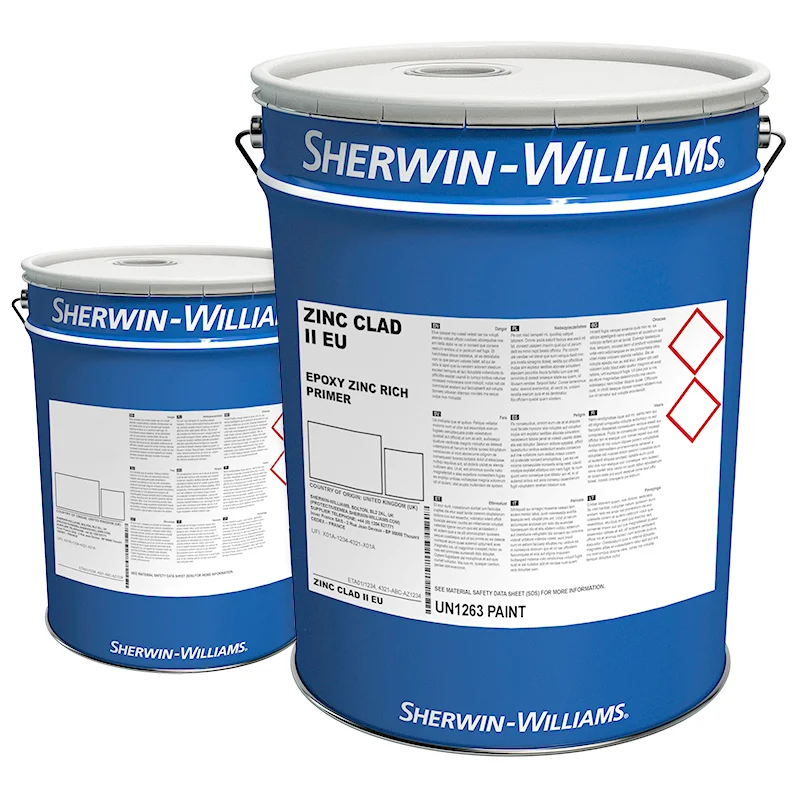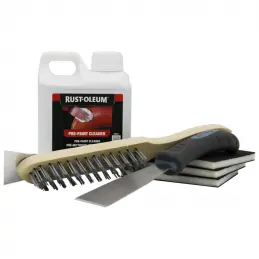- There are no more items in your cart
- Shipping Calculated at checkout
-
Sub-Total (inc. VAT)
£0.00
Sherwin-Williams Zinc Clad II EU is a self-curing solvent based, two component zinc silicate coating for the protection of blast cleaned steel surfaces. It is capable of withstanding temperatures up to 400°C and of curing at temperatures down to 0°C.
- For the protection of blast cleaned steel surfaces
- Capable of withstanding temperatures up to 400°C
- May be used as a holding primer at dry film thicknesses down to 20 microns (thinned 15% with Cleanser/Thinner No.4 after thorough mixing of the two components)
- Capable of curing at temperatures down to 0°C
Sherwin-Williams Zinc Clad II EU is a self-curing solvent based, two compenent zinc silicate coating for the protection of blast cleaned steel surfaces. It is capable of withstanding temperatures up to 400°C and of curing at temperatures down to 0°C.
Endorsements
- Complies with BS5493:1977 - Table 4E - Type EP2A.
- Complies with SSPC20:2004 – Level 1 Zinc content.
- Shell Specification VI(g) - Dep 40.48.00.30 - GEN.
- Complies with British Gas Specification PS PA9.
Recommended Uses
- For the protection of blast cleaned steel surfaces.
- Capable of withstanding temperatures up to 400°C.
- May be used as a holding primer at dry film thicknesses down to 20 microns (thinned 15% with Cleanser/Thinner No.4 after thorough mixing of the two components).
- Capable of curing at temperatures down to 0°C.
Recommended Topcoats
Prior to overcoating, any water soluble salts caused by weathering must be removed by either fresh water washing or flash blasting.
The use of a thin sealercoat or tie coat is essential before overcoating the material with a high build system, in order to reduce bubbling/pinholing effects.
The material is overcoatable by a wide range of non-saponifiable systems such as 2-pack epoxy, vinyl, chlorinated rubber, polyurethane etc. Consult Sherwin-Williams for detailed specifications.
The recoating times given above are a guide only, in all cases the Zinc Clad II EU should be fully cured before overcoating. See test for curing overleaf.
Surface Preparation
Blast clean to Sa21⁄2 BS EN ISO 8501-1:12007). Average surface profile in the range 30-75 microns.
May also be applied to a previous coat of Zinc Clad II EU with suitable cleaning of surface.
Application Equipment
Airless Spray
Nozzle Size: Max 0.45mm (18 thou)
Fan Angle: 65°
Operating Pressure: 120kg/cm² (1700 psi)
The airless spray details given above are intended as a guide only. Details such as fluid hose length and diameter, paint temperature and job shape and size all have an effect on
the spray tip and operating pressure chosen. However, the operating pressure should be the lowest possible consistent with satisfactory atomisation. As conditions will vary from job to job, it is the applicators’ responsibility to ensure that the equipment in use has been set up to give the best results. If in doubt Sherwin-Williams should be consulted.
Conventional Spray
Nozzle Size: 1.4mm (55 thou)
Atomising Pressure: 2.8kg/cm² (40 psi)
Fluid Pressure: 1.4kg/cm² (20 psi)
The details of atomising pressure, fluid pressure and nozzle size are given as a guide. It may be found that slight variations of pressure will provide optimum atomisation in some circumstances according to the set up in use. Atomising air pressure depends on the air cap in use and the fluid pressure depends on the length of line and direction of feed i.e. horizontal or vertical.
Brush
The material is suitable for brush application to small areas and for touch up purposes. Application of more than one coat may be necessary to give equivalent dry film thickness to a single spray applied coat.
Application Conditions & Overcoating
This material is supplied in 2 parts, a powder component ( supplied as two separate bags of zinc dust and filler pigment ) and a liquid component. The shelf life of the liquid component before mixing should not be allowed to exceed the expiry date on the container. Both bags of pigment which make up the powder component must be added slowly with mechanical stirring to the liquid component, which must be shaken thoroughly prior to use.
For application by conventional spray it is not normally necessary to sieve the mixed paint but if any lumps or bits are observed during the mixing then it should be strained through a fine gauze (40 mesh).
For application by airless spray, straining through a 40 mesh gauze is necessary immediately prior to use.
To avoid pigment packing in the equipment all filters including that in the gun should be removed from the airless spray equipment.
his material is very fast drying and should not be left in the spray equipment after use. All equipment, guns, lines, pots, etc., should be cleaned immediately after use with Cleanser/Thinner No.4.
The mixed paint should be stirred constantly to keep the pigment evenly dispersed.
This material may be applied at a temperature as low as 0oC providing that the surfaces are dry and the temperature of the surface to be painted is at least 3oC above dew point of the ambient air. The maximum temperature for application is 35oC; if for any reason it is desired to apply at a higher temperature, please consult Sherwin-Williams. Maximum relative humidity 95%, minimum 50%.
Over-application of this material should be avoided as zinc silicate coatings have a tendency to mud-cracking if applied at excessive thicknesses (Typically in excess of 125μ d.f.t.).
Where this material requires overcoating with a further coat of the same material, either by specification or because of inadequate thickness of the first coat, it is essential that the first coat should be fully cured before overcoating unless the sum of the two coats applied is less than 100 microns dry film thickness.
Additional Notes
Drying times, curing times and pot life should be considered as a guide only.
Test for Curing: First, rub the applied coating with a clean dry tissue or cloth to remove any dry overspray which may be present. A clean section of tissue/cloth (white) should then be soaked in Cleanser/ Thinner No.4 and then again rubbed gently on the coating for
no longer than 5 seconds, full cure is indicated by the resistance of the film to this test. If no trace of zinc is apparent, then the material is fully cured and overcoatable. If however, there is any removal of the material, it is not fully cured and should not be overcoated. A further test should be carried out after a further period of curing (Rating 5 according to ASTM D4752-03).
Both temperature and humidity influence rate of curing of zinc silicate coatings.
Numerical values quoted for physical data may vary slightly from batch to batch.
Data sheet
- Manufacturer
- Sherwin-Williams
- For Use By
- Industrial Use
- For Use On
- Steel
- Application Method
- Airless Spray, Spray, Brush
- Sheen
- Matt
- Colour
- Standard / Ready Mixed
- Single, Two or Three Pack
- Two-Pack
- Product Certifications
- BS5493:1977 - Table 4E - Type EP2A,
- Pack Size
- 5L
- Coverage
- 8.7m² per litre
- Touch Dry
- 5 Mins
- UN Number (Activator)
- UN1263
- UN Number (Base)
- UN3077
- Base Type
- Solvent-Based Epoxy
- Suitable For Use On
- Steel
- Finish
- Matt
- Application Method
- Spray
- Application Method
- Brush
- Product Usage Type
- Primer
- Product Range
- Zinc Clad
- Colour Family
- Grey
Questions
Question about the product
Be the first to ask a question about this product!
IMPORTANT SHIPPING & DELIVERY INFORMATION
Sherwin-Williams Zinc Clad II EU is only available with the shipping and delivery timescales listed below - please do not contact our Customer Support Team with enquiries about alternative or earlier shipping and delivery times.
Saturdays and Sundays, as well as Bank Holidays, are not classed as working days.
Orders placed after the cut-off for this product will not be processed for earliest dispatch until 9am the next working day.
All delivery costs below are excluding VAT



